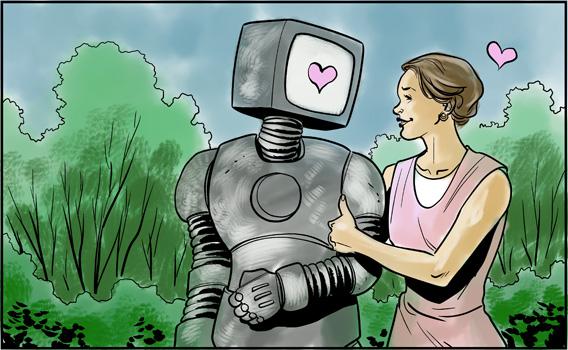Dan Slater boasts a relatively rare —for now—perspective on computer dating. Without it, he wouldn’t exist.
Slater’s parents met through Contact, Inc., a matchmaking service that debuted in 1965 and went defunct soon after—though not before the two college students paid $4 each and filled out Contact’s 100-question personality test. A rented mainframe computer nicknamed Eros tallied up their responses and concluded they were well-suited. And thus a Harvard boy got introduced to a Mount Holyoke girl.
Their union would eventually produce the author of Love in the Time of Algorithms. Subtitle: “What technology does to meeting and mating.” Slater’s book is partly a history of the many efforts to quantify courtship—beginning with a low-tech, punch-card battle between Contact (created by an MIT guy) and its mid-‘60s rival Operation Match (created by a Harvard guy) and carrying through to modern counterparts like OkCupid (created by a quartet of Harvard guys) and its parent company, Match.com (created by a Stanford MBA guy). Over the decades, a slew of brainy, entrepreneurial types have attempted to profit from our fear of dying alone. (Perhaps our elite universities need smokier music and moodier lighting at their mixers?)
The summer after I graduated from high school, I worked as a telemarketer for a pre-Internet matchmaking service called Successful Singles. We would cold-call unsuspecting folks at dinnertime, reaching them on their kitchen landlines as they ate what we presumed to be bleak microwave meals for one. We’d promise we could pair them with a perfect mate by employing intricate compatibility metrics. I still remember the opening of my script: “Hi, our research suggests that you’re one of the Boston area’s successful singles!”
This chipper pitch was occasionally met with interest. (And once in a while, inappropriate interest. “Well, you sure sound nice, are you single?” one woman purred to me through my headset. “I’m 17, ma’am,” I replied. I think the “ma’am” cooled her jets.) But more often I encountered silent hang-ups or pissed-off dismissals along the lines of: “What makes you think I need help getting dates? I get plenty of dates.” The prevailing notion held that dating services were a last resort catering to lonely hearted losers.
That social stigma has evaporated. Third-party, for-profit matchmaking is a booming sector these days—a $2 billion business in North America. Every unmarried person under 40 I know has at least dabbled in online dating. According to Slater, Match.com alone has around 1.5 million paying subscribers, with revenue of nearly $350 million a year. In 2011, it bought OkCupid for a cool $90 million.
Many current dating sites claim they can identify your future life-partner with computational precision. There are the “29 dimensions of compatibility” used by eHarmony in its “scientific approach to matching.” OKCupid profiles include stats such as “93% match” and “81% friend” and “17% enemy”—based on a patent-pending method that purports to be “a mathematical expression of how happy you’d be with each other.” One married, tech-fetishist pal of mine almost laments the fact that he met his wife in grad school the boring, old-fashioned way. “I sort of wish I’d put my fate in the hands of a robot,” he once said to me, regretfully, as I was describing my own online dating adventures. “I think it would be cool to know that an algorithm determined this was the absolute best person for you.”
Is the search for an ideal match truly less about poetry than equations? When we say that we seek a soul mate, are we talking about an empirical concept? Slater notes that several psychology professors—led by Northwestern’s Eli Finkel—have published a paper arguing it is “virtually impossible” for dating sites to “identify potential mates who are uniquely compatible.” The evidence simply isn’t there. It actually is possible to analyze an existing couple and, using various methods, predict whether the relationship will last. But, according to Finkel, there is basically no way to foresee the compatibility of two total strangers.
Which is sort of beside the point, in my experience. Online dating, in its most satisfying moments, isn’t about the idea of letting a computer algorithm locate the perfect person for you. (Sorry, tech-fetishist friend—you’ll just need to be satisfied with your awesome wife.) It’s about taking control, shopping around, and having more options. When you sign on to a dating site, you’re suddenly presented with many more potential mates than you could ever hope to find in traditional hunting grounds—your workplace, your circles of friends, closing time at that dive bar across the street. The real power of Internet matching is the scale.
Of course, single people have always had means to boost their odds. You can move to a city, where the population of as-yet-unclaimed hearts will be larger. You can lower your standards to broaden the radius of your dating pool. You can also just toss out game 24-7 with utter indiscretion. One acquaintance likes to tell random women on the street that he thinks they’re beautiful. “Like 1 in 5 will slow their roll a little and give me a smile,” he says. “And like 1 in 5 of those stop and talk to me and let me hand them my business card. And like 1 in 5 of those actually call me.” I would assume that at least 2 in 5 women he approaches think him a frightening skeezball. And I think, for better or worse, he’s OK with that ratio.
But on the Web you have the ability to sort, assess, and (politely) contact waaaay more prospects with waaaay more efficiency than even the most rampant sidewalk Romeo. OkCupid allows you to cross-reference by education, ethnicity, height, income, drinking and dietary habits, and a plethora of other variables. You can instantly pull up a list of profiles that meet your criteria, each with accompanying personal essays and photos. And then you can send intriguing matches a message without leaving the page.

Photo by Sophie Herbert
An excerpt from Slater’s book recently ran in the Atlantic, drawing flak for its portrayal of “Jacob”—a somewhat shiftless ne’er-do-well and inveterate online dater. Jacob mows through an endless series of women, many of them seemingly out of his league. He’s quick to move on whenever things get real because there’s forever another conquest awaiting him inside his Web browser. Internet dating offers him so much choice, he never needs to choose. Critics (including in Slate) have noted that this excerpt failed to include any female perspective. Do women approve of a technological advance that seems almost perfectly designed to empower cads?
In his book, Slater does introduce us to some female online daters. My sense is that women often face the same smorgasbord of choice, even if their goals may differ from Jacob’s. Slater recounts the saga of “Alexis,” for example, a young woman who sometimes finds herself “itching to get back on OkC, to see who’s there this time around.” Consider that in Thursday’s Slate excerpt of Amy Webb’s new book Data: A Love Story, Webb includes an absurdly specific list of 70-odd traits she demanded in a partner. Webb could have little faith that she might actually discover one man in possession of these many qualities if she were merely meeting friends-of-friends and dudes in bars. But when you sift through the truly enormous pile of prospects you encounter when dating online, suddenly anything seems possible.
I am no Jacob. I’m not looking to, as one charming acquaintance of mine puts it, “plow and bounce.” Even if I never went out and met in person any of the women I peruse on OkCupid, I’d still find the endless options overwhelming. I click through profiles like I’m shopping for clothes. I look at photos and envision 40-year marriages. Would I be happier making my life with that pixieish Dutch girl who works at the United Nations? Or that sensible-seeming doctor on the Upper East Side? Or that punky fashion designer who lives in Prospect Heights and enjoys New Wave cinema?
You might think it’d be reassuring to scour thousands of potential mates and feel that you are making a well-informed pick from a vast selection. But I find surfing around on OkCupid to be the opposite of reassuring. It occasions “decision anxiety.” What’s the difference between someone who’s deemed a 96 percent match for me and someone who’s 97 percent? They both sound like really good matches! Both will undoubtedly post fetching photos and delightful essays. Dozens and dozens of other profiles will seem equally promising. Soon those profiles are a blur of nice haircuts, international travel, yoga, and sriracha. (I can only imagine that my own profile features in similar blurs, whirring through female heads.) I can’t ask out every one of these accomplished, winsome ladies—there are only so many days in the week, and I have only so much energy for first-date weirdness. And yet I can’t know if any of them are genuine girlfriend material without looking them in the eye. I have to meet them all for coffee or a drink and determine that they do in fact look like their photos, that they can carry on a conversation, that they won’t spend the entire date musing about why they like to self-harm. And I have to give them a chance to assess me in 3-D, too.
I’ve gone on dates with women who have zero self-awareness. Women who give 45-minute monologues about themselves without asking me a single question. Women who show up and tell me that, “by the way, right before I got here, I took a whole bunch of bong rips.” (Which is not, in itself, disqualifying, but is an interesting choice for a first date. Oh, OK, I went back to her apartment that night and smoked weed with her. But nothing else happened! And the weed wasn’t that strong.)
Getting set up by friends eliminates most of the crazies. But I find my married friends just tend to chuck folks together willy-nilly, with not a ton of thought given to whether the pair is actually suited. “Hey, they’re both single, let’s fix ‘em up!” seems to be the attitude—the way you’d plug a leaky bucket with whatever you have at hand, even a piece of chewed gum. (In this scenario I am sometimes the leaky bucket, and sometimes the chewed gum.)
Far better, of course, would be to learn about a person in context. To see her interact with others—flash kindness, tact, and wisdom in a myriad of nondating scenarios. A friend of mine tells me she first fell for her husband when she saw him give sincere, tough-love advice to one of his buddies.
It’s easy to observe someone over time like this in a school or work setting. But what if you’re not in school anymore? What if work (for whatever reason, and certainly through no fault of the gorgeous and intelligent women who work at the Slate office) fails to produce an inamorata? I sometimes tell myself I’d be better off in a small town, my choices constrained. I’d just marry whichever girl flaunted—over the course of several rec-hall dances and town-square picnics—the slyest wit and the cutest smile. Assuming she’d have me and wasn’t spending all her time cruising OkCupid for an upgrade.
Until then, I’ll keep updating my profile, clicking through photos of 36-year-old marketing executives in Brooklyn Heights and 33-year-old graphic designers in Bushwick. Maybe it’ll work out. Though it didn’t exactly for Slater’s parents. They separated while he was still a toddler. All the computational power of Eros still didn’t quite add up to a happy ending.
—
Love in the Time of Algorithms by Dan Slater. Current.
See all the pieces in this month’s Slate Book Review.
Sign up for the Slate Book Review monthly newsletter.
